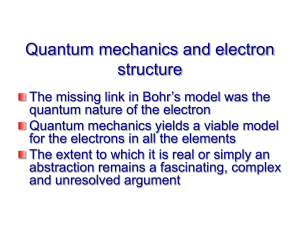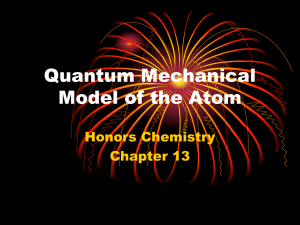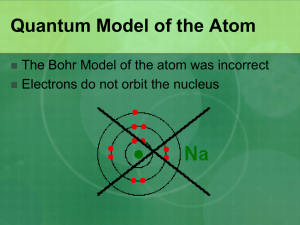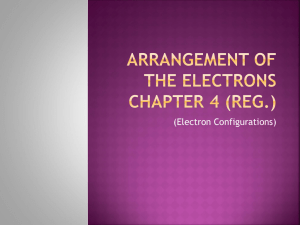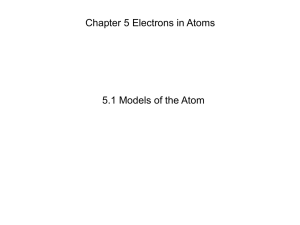File
advertisement
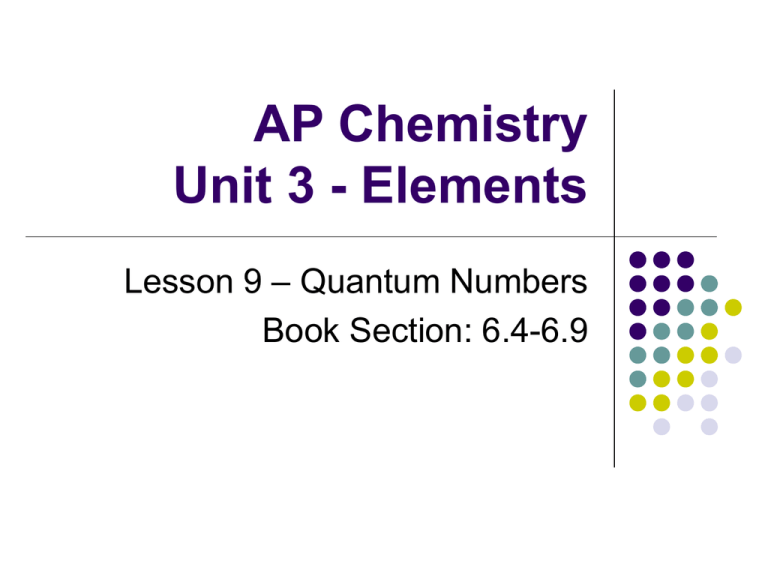
AP Chemistry Unit 3 - Elements Lesson 9 – Quantum Numbers Book Section: 6.4-6.9 Quantum Numbers Solving the wave equation gives a set of wave functions, or orbitals, and their corresponding energies. Each orbital describes a spatial distribution of electron density. An orbital is described by a set of three quantum numbers. Principal Quantum Number (n) The principal quantum number, n, describes the energy level on which the orbital resides. The values of n are integers 1 and above. n = 1, 2, 3… Angular Momentum Quantum Number (l) This quantum number defines the shape of the orbital. Allowed values of l are integers ranging from 0 to n – 1. We use letter designations to communicate the different values of l and, therefore, the shapes and types of orbitals. Value of l Type of orbital 0 1 2 3 s p d f Magnetic Quantum Number (ml) The magnetic quantum number describes the threedimensional orientation of the orbital. Allowed values of ml are integers ranging from –l to +l: l ml l Therefore, on any given energy level, there can be up to 1 s orbital, 3 p orbitals, 5 d orbitals, 7 f orbitals, etc. Magnetic Quantum Number (ml) Orbitals with the same value of n form a shell. Different orbital types within a shell are subshells. s Orbitals The value of l for s orbitals is 0. They are spherical in shape. The radius of the sphere increases with the value of n. s Orbitals Observing a graph of probabilities of finding an electron versus distance from the nucleus, we see that s orbitals possess n-1 nodes, or regions where there is 0 probability of finding an electron. p Orbitals The value of l for p orbitals is 1. They have two lobes with a node between them. d Orbitals The value of l for a d orbital is 2. Four of the five d orbitals have 4 lobes; the other resembles a p orbital with a doughnut around the center. Energies of Orbitals For a one-electron hydrogen atom, orbitals on the same energy level have the same energy. That is, they are degenerate. Energies of Orbitals As the number of electrons increases, though, so does the repulsion between them. Therefore, in manyelectron atoms, orbitals on the same energy level are no longer degenerate. Spin Quantum Number, ms In the 1920s, it was discovered that two electrons in the same orbital do not have exactly the same energy. The “spin” of an electron describes its magnetic field, which affects its energy. Spin Quantum Number, ms This led to a fourth quantum number, the spin quantum number, ms. The spin quantum number only has 2 allowed values: +1/2 and -1/2. Pauli Exclusion Principle No two electrons in the same atom can have exactly the same energy. Therefore, no two electrons in the same atom can have identical sets of quantum numbers. Sample Question Predict the number of subshells in the fourth shell, that is, for n = 4. Give the label for these subshells. How many orbitals are in each of these subshells? Sample Question Predict the number of subshells in the fourth shell, that is, for n = 4. Give the label for these subshells. 4 (l = 0, 1, 2, 3) s, p, d, f How many orbitals are in each of these subshells? s–1 p–3 d–5 f–7 AP Questions A) B) C) D) E) 1994 MC #27: Which of the following sets of quantum numbers (n, l, ml, ms) best describes the valence electron of highest energy in a groundstate gallium atom (atomic number 31)? 4, 0, 0, ½ 4, 0, 1, ½ 4, 1, 1, ½ 4, 1, 2, ½ 4, 2, 0, ½ AP Questions A) B) C) D) E) 1994 MC #27: Which of the following sets of quantum numbers (n, l, ml, ms) best describes the valence electron of highest energy in a groundstate gallium atom (atomic number 31)? 4, 0, 0, ½ 4, 0, 1, ½ 4, 1, 1, ½ - 48% correct, medium 4, 1, 2, ½ 4, 2, 0, ½ AP Questions A) B) C) D) E) 1984 MC #70: One of the outermost electrons in a strontium atom in the ground state can be described by which of the following sets of four quantum numbers? 5, 2, 0, ½ 5, 1, 1, ½ 5, 1, 0, ½ 5, 0, 1, ½ 5, 0, 0, ½ AP Questions A) B) C) D) E) 1984 MC #70: One of the outermost electrons in a strontium atom in the ground state can be described by which of the following sets of four quantum numbers? 5, 2, 0, ½ 5, 1, 1, ½ 5, 1, 0, ½ 5, 0, 1, ½ 5, 0, 0, ½ - 41% correct, medium HW: 6.48, 50, 52, 54, 56, 58 This Week: Thursday – Gravimetric Analysis of a Chloride Salt, Quantitative Analysis of Soluble Sulfate Due Friday – Electron Configurations (6.4-6.9) 10/18 – Gravimetric Analysis of a Chloride Salt Due 10/20 – Elements Exam 10/21 – Problem Set 2 Due
